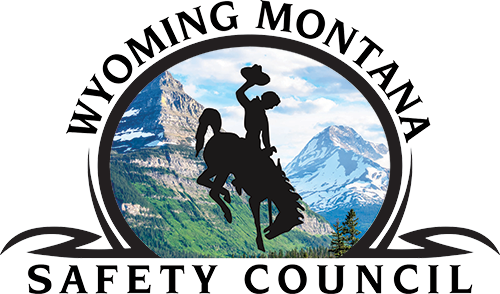Baby Proofing and Child Safety at Home:
A Complete Guide
Sadly, the most common causes of injuries and death for children younger than 18 are preventable accidents. Eliminating the serious risks from your home will allow you to relax and let your kids roam more freely
Table of Contents
Electrical Safety for Kids
Preventing Injuries from Falls
TV & Internet Safety for Kids
Choking and Suffocation Safety for Kids
Kitchen Safety for Kids
Poison Safety for Kids
Firearm & Gun Safety for Kids
Bathroom, Laundry Room, and Pool Safety
Car, Garage, and Outdoor Safety
Childproofing Tips
Conclusion

Following these tips and suggestions will significantly reduce the hidden dangers in and around your home. We’ll also introduce different products and ideas to help you protect children of all ages. Let’s get started!
Electrical Safety for Kids
For new parents, the first and most impactful change to make when childproofing a home or workspace is to cover, lock, or block off all exposed outlets. When it comes to small children, if there is something they’re not supposed to do, they will do it.
If there is an exposed hole in a wall, your little one may touch it or stick something in it. Electrical outlets are deadly and are found throughout every home. Approximately 100 kids die each year by electrocution, and many others are seriously hurt. Here are some rules and tips:
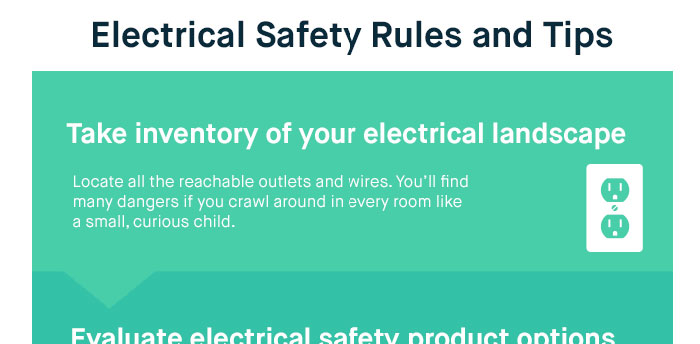
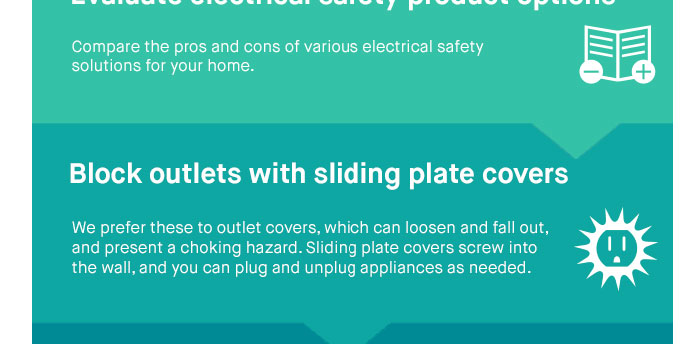
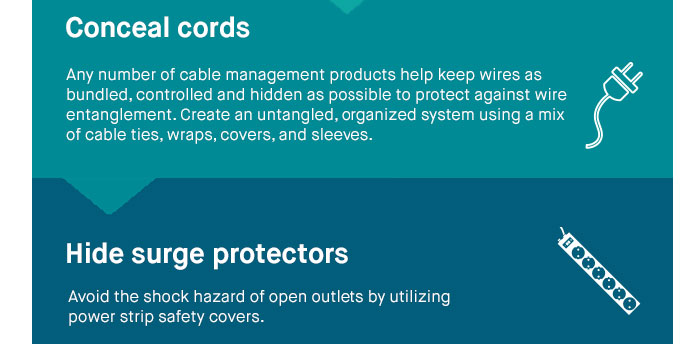
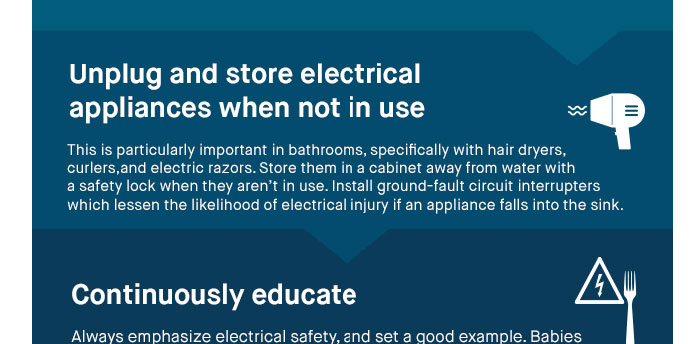

Preventing Injuries from Falls
Children fall down a lot, especially while learning how to walk, run, and climb. While we can’t guarantee soft landings, we’ve prepared this section to increase the odds.
In 2013, more than 2.5 million unintentional falls required an emergency room visit, and many of these accidents are preventable. Similar to wearing helmets and other proper safety gear while riding bicycles, skateboarding, and playing other sports, there are many things we can do in and around the house to reduce the risk of fall related injuries.

- Be sure outdoor playground equipment is built securely with no loose parts.
- Avoid playgrounds with concrete other hard surfaces.
- If your small child is playing up high on playground equipment, be aware of any open spaces where he or she could fall from, and be there to catch them.

- Don’t let kids lean on window screens. They’re designed to keep insects out, and can’t support the weight of a child.
- Use window guards to prevent your child from falling through screens or open windows. Make sure window guards are childproof but easy for adults to remove in case of fire.
- Window locks are not just for the security of keeping bad guys out, they also keep the little ones in. If you already have window locks, use them.
Falling Down Staircases
Stairs are among of the most frequent places for falls, but with a little preparation, these accidents are mostly preventable. It’s easy to restrict young children’s access to staircases through the use of fences or baby gates at the top and bottom entrances, but you should never leave a small child unattended around stairs – even gated ones.
- Install staircase safety gates to prevent accidental falls for young children and pets. Do not use pressure–mounted gates on stairs, as they can slip under too much pressure.
- Use safety gates at the doors of the children’s rooms to keep them from the stairs.
- Attach a clear barrier such as plexiglass along banisters and railings.
- Avoid accordion gates, which can trap a child’s head.

- Attach furniture such as cabinets to the studs in your walls with furniture straps.
- Utilize museum putty underneath all shelved items such as ornamental keepsakes to reduce the likelihood of those objects falling and breaking when bumped or shaken.
- If you have a flat screen TV, consider a wall mount instead of a basic stand.
TV & Internet Safety for Kids
Our responsibility as caretakers also extends beyond immediate physical safety and into preserving emotional health. It takes a great deal of active awareness and preparation to control the content of images and videos children are exposed to, especially because screens are available almost everywhere. Whether viewed through smart phones, tablets, personal computers or televisions, exposure to age–inappropriate material can cause lasting effects, including triggering unnecessary fear and insecurities.

- Preview T.V. shows and movies before your children watch them.
- Keep televisions and internet connected devices out of children’s bedrooms.
- Familiarize yourself with the Television Rating System and learn how to read TV Parental Guidelines for both all forms of media.

- Put password protected locks on all wireless devices that don’t have child-friendly settings.
- Teach kids about the importance of not giving away personal information, then create and enforce internet safety rules.
- Set privacy settings for you household’s WI–FI.
- Teach children about the permanence of internet and social media content, and online reputation management.
Choking and Suffocation Safety for Kids
Every meal or snack comes with a risk of choking, and even playtime for small children can be risky if the toys have small parts. Thankfully, you are reading this guide and are about to learn about several preventive measures that can reduce the likelihood of this traumatic occurrence.
Choking can be fatal for kids and adults. Choking due to a foreign object resulted in 162,000 deaths in 2013.8 In 2010, almost 1,200 kids died from unintentional suffocation, and more than 75% of them were younger than one year old.
Infants exposed to unsafe sleep environments are at great risk of injury or death. Entrapment, suffocation, and strangulation can lead to sudden infant death syndrome (SIDS), death from spontaneous cessation of breathing. Here are some safety guidelines on how to to reduce the risk of SIDS and create a safe sleep environment for babies, along with other rules to live by to prevent choking:
1. Place newborns supine (lying face up) within the first few hours after birth.
2. Put babies to sleep on their backs to reduce risk of suffocation. Some babies may have medical conditions where they need to sleep on their stomachs, so consult a pediatrician to know what is best for your baby.
3. Move babies to a firm sleep surface as soon as possible when they fall asleep in a car safety seat, stroller, swing, infant carrier, or infant sling. Make sure your sleep surface meets current safety standards.
4. Do not use a crib with drop-side rails. Gaps can form between the crib mattress and the drop side rails. A baby’s head could get caught between the mattress and the side rails, leading to suffocation, or the baby could fall out of the crib. In 2011, the U.S. Consumer Product Safety Commission banned manufacturers from making new cribs with this feature.
5. Never put a baby to sleep on a chair, couch, waterbed, cushion, or fur rug. Take a few minutes to check and make sure your crib or bassinet has not been recalled at the Consumer Product Safety Commission.
6. Remove crib bumper pads, pillows, blankets, stuffed animals and extra “stuff” in the crib. For children younger than 12 months old, these can present suffocation, entrapment, or strangulation hazards.
7. Babies should sleep in their own beds. Babies who sleep in the same bed as their parents are at a greater risk of SIDS, suffocation, or strangulation. Parents can roll onto babies during sleep or babies can get tangled in the sheets or blankets.
8. Keep babies away from smokers and places where people smoke.
9. Regularly offer pacifiers to babies at naptime and bedtime. This helps to reduce the risk of SIDS.
10. Do not use specialty sleeping products: Products such as wedges, positioners, special mattresses, and specialized sleep surfaces claim to reduce the risk of SIDS, but have not been proven to reduce the risk of SIDS and in some cases, infants have suffocated while using these products.
11. Take CPR courses and consider getting CPR certified. Also, check with your babysitter or childcare professional to make sure they are up to date with the latest in CPR and first aid practices.
12. Be present whenever your young child is eating. Be sure to consult a pediatrician to understand what foods your child should or shouldn’t eat at their age.
13. Choose age appropriate child–safe toys. The general rule of thumb is anything that fits inside a roll of toilet paper is a choking hazard.
14. Regularly scan the environment for loose chokeable items within a child’s reach.
15. Do not leave out any small objects that may be accidentally ingested.
Kitchen Safety for Kids
Kitchens are full of potential hazards, including fire, gas, electricity, sharp utensils, chemicals, breakable glass and dishes, and garbage disposals. In the study Pediatric Burn Injuries Treated in Emergency Departments in the U.S. Between 1990 and 2006, researchers learned thermal burns caused by heat and fire accounted for nearly 60 percent of all child injuries, and most often occurred due to kitchen–related items including appliances. Here are some childproofing safety tips for you to protect little ones from the dangers of the kitchen.
Electrical Appliances
- Unplug all appliances when not in use.
- Cover garbage disposal and with a protective screen.
- Teach appliance safety (don’t reach into a blender, don’t poke the toaster with a knife, etc.)

- Use stove knob covers to prevent little ones from accessing the stove controls. The hinged lid allows adults convenient access to stove knobs, without needing to remove the product.
- Don’t let kids touch or sit on the stove.
- When cooking, use back burners whenever possible and turn all pot handles toward the back of the stove so your child can’t reach up and grab them.
- As kids start cooking for themselves, make sure they understand how hot stoves, pots, and pans can get, and that hot foods can burn.
- Don’t let your kids play with pots and pans. They may mistake the pan on the stove for a toy, which can result in serious injury. You might consider having one cabinet that is safe for your child within things like Tupperware or cloth napkins.

- Decide what age is appropriate for your child, and enforce rules as necessary.
- Leave an oven mitt near the microwave to make grabbing hot objects less of a hazard.
- Do not warm baby bottles in a microwave oven. The liquid may heat unevenly, and pockets of milk may be hot enough to scald a baby’s mouth.

- Install adhesive mount safety latches on all cabinets and cupboards with contents that could pose risks to children, such as alcohol, plastic bags, and vitamins.
- Store matches and lighters out of children’s reach.
- Keep spices out of children’s reach. Many are unhealthy in large doses.
- Use a child–resistant garbage can or keep your trash behind closed doors in a locked cabinet.
- Keep aluminum foil, waxed paper, and plastic wrap dispensers away from children. The serrated edges on the boxes can cut little fingers.
Poison Safety for Kids
Children are curious little adventurers, and that’s a good thing. Unfortunately, one of the dangers of this curiosity is that we are surrounded by poisonous objects. Children and adults can easily be poisoned by eating, drinking, smelling or even touching the wrong things.
44% of poison exposures involve children younger than six, so it’s imperative you take measures to prevent occurrences and know what to do in an emergency.

Responding to Poisoning Emergencies in 3 Steps
Follow these three steps if you suspect a poisoning:
- Check the scene and the person. Try to find out what poison was taken. Look for any containers and take them with you to the phone.
- Call the National Poison Control Center at (800) 222-1222 and follow their instructions.
- Care for any life threatening conditions found. DO NOT give the person anything to eat or drink unless directed to do so by the National Poison Control Center or Emergency Medical Services (EMS) personnel.
Click here for additional information
Poison Prevention
One of your first steps should be to keep poisonous household items in locked cabinets out of children’s reach. Commonly used medications such as Amitriptyline or Bengay, for example, are highly toxic if ingested. One Amitriptyline pill is enough to seriously injure or kill a small child. Also, be aware that foul smells or tastes will not keep curious minds away, and young children explore with their mouth.
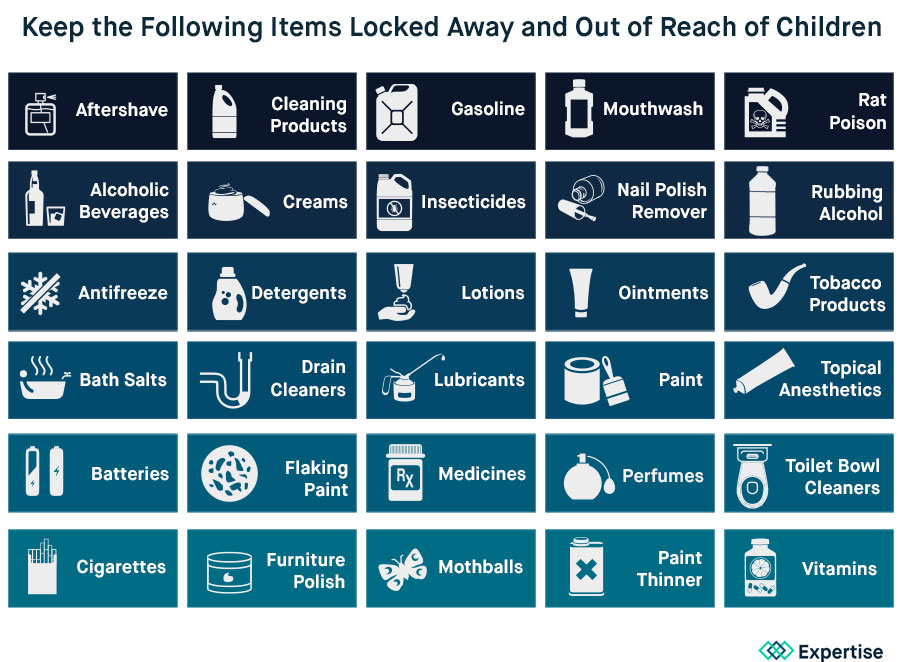
Drug & Alcohol Safety
It’s important to have an open discussion with your children about drug & alcohol safety and establish expectations, safety instructions, and health rules. Make sure everyone knows what areas are off limits. Avoiding uncomfortable conversations won’t make your kids less curious, and doesn’t let you establish house rules.
Prescription Medication Safety
Accidental poisonings from prescription drugs present a major health risk. Medication poisoning is a leading cause of injury among children, and a pill that is safe for an adult can result in serious injury – even death – for a small child. It’s best to keep your medicine cabinet locked.
Firearm & Gun Safety for Kids
Guns are not toys, though they may seem that way to children. Federal data from the Centers for Disease Control and Prevention indicate that in 2013, more than 400 American children age 14 and younger died from unintentional shootings, and innocent children accounted for more than 1 out of every 100 shooting related deaths that year.
The U.S. General Accounting Office estimated 31% of accidental firearm-related deaths can be prevented by the addition of two devices: a child proof safety lock and a loading indicator, a safety device that indicates whether a firearm is loaded and a round remains in the chamber. These are the first two items you should buy.
As children get older, they’re no longer thwarted by child locks, but it is easier to communicate about firearm safety. Here are some additional safety guidelines that should be of vital importance for gun owners, especially as your children get older:
- Firearms need to be stored in a locked safe.
- Store ammunition in a separate locked location from the firearm.
- Talk to your children about gun safety and make sure they understand the risks of reckless gun behavior.
- Familiarize yourself with and understand your state’s gun laws.
Bathroom, Laundry Room, and Pool Safety
There are many dangers to children where water, heat, or electricity is involved. 10 people per day die of drowning in the U.S. Babies can drown in as little as 1 inch of water, and it can happen very quickly.
Children are also more susceptible to burns because they have thinner skin than adults. Scalding can occur if someone comes in contact with as hot water in a bath or from a faucet, or even from steam. Contact burns are a risk around hot metals such as a hair dryer or a curling iron. Here are some ways to prevent drowning, scalding, electrocution and other injuries which can happen in bathrooms, laundry rooms and pools:

- Keep all bathroom doors closed when they not in use.
- Never leave babies unattended in or near a bath.
- Unplug all electric appliances in the bathroom (hair dryer, iron, stereo, etc.).
- Use a non–slip bath mat or bath decal stickers to prevent slipping.
- Either equip your faucets and shower with an anti–scalding device or set the water heater to 120 degrees or lower to prevent hot water scalding.
- Lock any cabinets with makeup, medication, toothpaste, cleaner, lotions, hairsprays – anything that might be toxic. (see Poisoning Hazards).
- Install toilet seat lid locks on all of your toilets to protect young children from falling into toilet bowls and also to prevent injuries from heavy toilet lids falling on little fingers or heads.
- When potty training, do not leave small children unattended near toilets.
- Consider installing built–in potty seats to prevent children from slipping into the toilet.

- Install washer and dryer locks or locking straps to secure front loading machines to keep kids from climbing into your washer and/or dryer.
- Keep all spray bottles, laundry detergents, and chemicals out of reach of children.

- Always supervise kids when they are near or in any pool or body of water.
- Teach your children to swim, or take them to swimming classes. It is imperative children practice basic swimming and floating techniques so they don’t panic in the water.
- If your child is still learning to swim, make sure he or she wears life jackets in and around natural bodies of water and pools.
- If you have a pool, install a child–safe pool fence with self–closing and self–latching gates. Putting a lock on your pool gate adds additional safety and security.
- Take CPR courses and consider getting CPR certified.
- Know the signs of secondary drowning, which can occur when someone aspirates water.
Car, Garage, and Outdoor Safety
Automobiles and garages can both be extremely dangerous for children. In fact, vehicle–related injuries are the leading cause of preventable deaths and injuries to children in the United States. You can reduce the risk of child death and injury by as much as 71% by correctly installing and using child safety seats, which will make you one of only 27% who use their car seats correctly. Here are some tips to avoid the many hazards in your garage and on the road:

- Install mirrors in your garage to eliminate blind spots.
- Do not leave sharp or dangerous tools lying around.
- Unplug power tools and devices when they are not in use.
- Use safety guards on all tools and if possible, lock them up and store them out of the reach of children.
- Store paints, chemicals, poisons and cleaning products on high shelves and secure them in so they won’t fall in the case of an earthquake.

- Get your car seat checked for proper installation by a certified child passenger safety technician. Some local fire and police stations provide free car seat checks. Also make sure it’s appropriate for your child’s age, weight and height.
- Buckle up every time you drive! Lead by example by buckling your seat belt before you even start the car.
- Do not allow your child to play in the car unattended.
- Never allow your child to sit on your lap in a moving vehicle.
- Kids should sit in the back seat until about age 13. This significantly reduces their chance of serious injury.
- Never leave a child unattended in a car. Without exception, always take children with you no matter how quick a stop you’re making.
- Keep loose items stored safely in compartments or pockets in your car to prevent them from becoming projectiles in the event of a car accident.

- When spending longer periods of time outdoors, be sure to regularly apply sunscreen. Even cloudy skies can cause sunburns.
- Backyards are generally safer than front yards due to being more controlled environments and usually distanced from moving vehicles.
- Fenced in yards offer increased privacy and protection from traffic, strangers and wild animals.
- Keep a watchful eye on children, especially smaller children who tend to put everything in their mouths.
- Having a secure, gated or fenced in yard to play in ensures that if children temporarily get away from your line of sight you still know they are in a contained space.
Play Structure Safety
- Make sure children aren’t left unattended.
- Play structures should always be age, size and skill appropriate. Use common sense and stay closer for smaller, less mobile or agile children.
- Check outdoor toys and play structures for insects, wild animals, animal feces, and other undesirables before letting children play with them.
Garden and Landscape Safety
- Be careful not to plant poisonous plants in your garden and do not buy them for your house or workspace. Common houseplants such as poinsettias or rhubarb as well as garden species such as daphne or mushrooms that grow in the garden can be highly toxic or even fatal.
- For a complete list, check out Western Garden Book or similar resources.
Childproofing Tips
Childproofing Walls
- Keep art and other wall displayed items out of a child’s reach.
- Use security wall hangers to hang decorative wall art and mirrors.
- Install fireplace safety locks to keep kids out.
Childproofing Doors
- Place doorknob covers on the front door and all exits to keep young kids in the house and to prevent them from opening the door to strangers.
- Install the Door Monkey on doors to rooms that present risks as a non-permanent solution to keep children in sight and out of trouble.
- Teach your children about the importance of avoiding strangers.
Childproofing Furniture
- Protect children from sharp corners & edges by installing foam edge guards and corner cushions. If possible, try to buy furniture that has rounded corners and edges.
- Secure large objects such as armoires and televisions to your wall to prevent falling objects.
Conclusion
In this guide, we’ve covered many ways to prevent injuries and reduce hazards, plus how to plan and prepare for or respond to emergencies. You now have professional child-proofing ideas for every room and appliance in your home, as well as the outdoor areas. Now you can prepare your home with the necessary precautions to eliminate as many risks as possible!
Following the advice in this home safety guide may not just help you prevent injuries and relieve some of the stress of parenting, it may help you save the life of little ones you love. Taking action to make your home safer and preparing for many types of emergencies will help you to relieve stress and rest easy.
Baby proofing doesn’t completely eliminate the risk of injury, but it does significantly reduces the majority of the risks. Whether you’re in a new or old home, parts of your living space may not be able to be made safer unless you hire a home remodeler. Dont hesitate to seek help to make renovation and child–proofing easier!
- https://www.cdc.gov/safechild/index.html
- https://www.nsc.org/learn/safety-knowledge/Pages/safety-at-home-falls.aspx
- https://www.cdc.gov/homeandrecreationalsafety/Playground-Injuries/playgroundinjuries-factsheet.htm
- https://www.cpsc.gov/PageFiles/108596/playground.pdf
- https://kidshealth.org/parent/firstaid_safe/home/safety_falls.html
- https://www.apa.org/monitor/jun04/protecting.aspx
- https://transition.fcc.gov/Bureaus/Mass_Media/Factsheets/factvchip.html
- https://www.thelancet.com/journals/lancet/article/PIIS0140-6736(14)61682-2/abstract
- https://pediatrics.aappublications.org/content/128/5/e1341.full
- https://www.aap.org/en-us/about-the-aap/aap-press-room/Pages/Burn-Injuries-Common,-But-Preventable-in-Young-Children.aspx
- https://www.healthychildren.org/English/ages-stages/baby/feeding-nutrition/Pages/Baby-Bottles-And-Bisphenol-A-BPA.aspx
- https://www.safekids.org/car-seat

